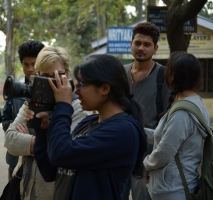The sari is considered to be the garment of the quintessential Indian woman. Timeless tales recount how the beauty of a woman is enhanced by leaps and bounds as she drapes the sari around her! Much as fancy as it sounds, the fact that the sari is dying a slow death cannot be ignored.
Yes, there are still dance sequences or songs in Bollywood films where sari clad women can be seen dancing around the trees. However, the sari we see is just the revamped designer version of the garment that has the history of our nation so intricately associated with it.
The recently concluded Wills Lifestyle India Fashion Week 2013 saw some of the famous Indian designers coming up with new avatars of the sari like the suspender sari (sari over palazzo pants) by Masaba Gupta, the structured sari dress (a short sari dress worn over cigarette pants) by Abraham and Thakore, saris paired with trench coats and military style jackets by Anju Modi etc.
While skeptics might argue and state that the garment can be interpreted in myriad ways but innovation is great only till the time the original doesn’t start to fade away.
“The sari, as how we understand it today, has a completely different meaning from what it had a few years ago. Today, if I am wearing a cotton sari on a daily basis, I am either a social worker or a college professor!” says Anita Singh, a content writer based in Delhi.
The Indian middle class’ relation with the sari is not what it used to be! Back in the 70s and even 80s when wearing a sari to work was almost a given seems like the dinosaur’s era now! Today it has been replaced by the kurta and tights (leggings being quite a fad these days!).
“I usually prefer wearing my western formals to work. Since I have to go on so many meetings and meet clients on almost a daily basis, wearing a sari frankly seems like a ridiculous option,” says Gitika Aggarwal, a marketing professional.
While some designers have been known for giving the sari some quirky ‘avatars’, designers like Sabyasachi Mukherjee are largely credited with bringing the sari back with a bang! Involved in the makeovers of stars like Rani Mukherjee and Vidya Balan, Sabyasachi has found fans cutting across class boundaries. The reason being, he has tried to revive the roots of this rich Indian tradition.
His ‘Save the Sari’ project is one such CSR initiative by his company that seeks to support the sari weavers in their lean season and to essentially make people take pride in wearing the saris and weaves again!
“Sabyasachi’s Save the Sari project basically looks at over 50 weavers in Andhra Pradesh and Bengal and ensures that they get work commissioned to them especially during the months of summer. With handloom industry slowly dying in our country, this initiative is a very noble one, something that many Indian designers might not indulge in,” says Akriti Agarwal of Very Truly Yours (VTY), the PR agency that represents Sabyasachi.
Yet another initiative has been taken by the father-daughter duo of Bharat and Palak Shah, who opened the sari boutique called Ekaya in Defence Colony last September. Originally based in Banaras, their family has been in this business for many decades now. However, what brought them to Delhi after all these years is to revive the Banarasi saree amongst the people in the metros and promote all types of handwoven and hand-embroidered saris.
“Ekaya saris are classic and what makes them so is the fact that they represent the hard work of the tens of thousands of weavers who ensure that the sari remains timeless! Ekaya has access to over 10,000 craftsmen as well as weavers from there and besides the Banarasi brocade there are also saris in tussar silk, khadi etc,” adds Akriti of VTY that also manages Ekaya in New Delhi.
There are also people like textile expert Rta Kapur Chishti who are considered to be sari experts. The textile researcher, who was travelled across the length and breadth of the country studying the garment, has her own ‘Sari school’ in New Delhi. Chishti is also the author of Saris: Tradition and Beyond, in which she explores 108 ways of draping a sari. There are various workshops that are held there on the different ways to drape the garment. Apparently there are 108 different styles of wearing the sari that are taught at the school.
Whether or not these initiatives would be able to revive what we call the traditional Indian sari waits to be seen. The sari as can be seen today is a garment that is going through a possible ‘rite of passage’, where the traditional avatar of the garment is being revived dexterously by some in the society but the modern avatar is being readily accepted too!







































